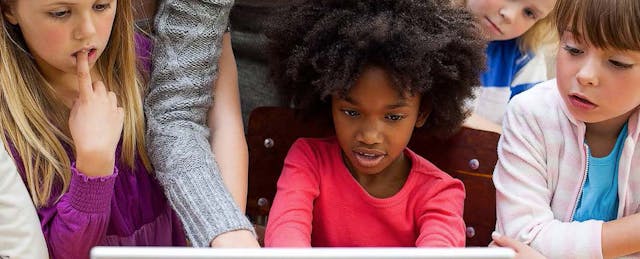The world has gone digital, our days are awash in audiovisual experiences. And as we await the release of the annual “National Report Card” on children’s reading skills next month, many reading experts are already questioning how digital devices may impact our kids’ mastery of literacy skills.
Their concerns are valid: US reading scores have flatlined since 2004. Nationwide, nearly two-thirds of fourth-graders are unable to reach the “proficient” level on reading tests.
Despite spending billions on reforms like smaller class sizes and intensive reading programs, and millions on new apps and platforms, test scores and market innovations are stuck in wet cement. Innovations in the burgeoning literacy apps marketplace have done little, at least so far, to stanch the decline.
Developers and educators must respond to an ongoing challenge that is America’s “quiet crisis,” and it is past time to modernize our approach.
In our new book, Tap, Click, Read: Growing Readers in a World of Screens, we document a rapidly changing literacy landscape for preschool and primary-grade kids. On one end, children in privileged environments enjoy mentors who help them navigate the media maze and learn how to become focused, careful readers with skills in filtering, creating and making sense of the barrage of information coming their way. But about half of all kids ages 0-8—some 15 million—are not getting that kind of support. As higher-income families begin to capitalize on learning opportunities that come with online access, America is at risk of slipping into an even starker world of haves and have-nots.
Weak readers fall behind, often drop out, and struggle on the job market. Governors and mayors want to make sure that all third graders become fluent readers within the next decade. But most programs and policies are not working. Why?
Our research points to the need for a new approach that integrates higher quality early-learning programs and digital media as a vital, untapped asset for engaging families in the building blocks of literacy. This 21st-century formulation that embraces new media and employs the best practices in early childhood literacy is what we call “readia.”
For several years, the Joan Ganz Cooney Center and New America have been conducting field research on modern families’ uses of digital media for learning and the exploding technology marketplace. We’ve interviewed literacy experts and visited programs to find out whether technology is impeding or improving the teaching of reading. There are a couple things that clearly don’t work: using technology as a babysitter or simply relying on the app store to find quality content. So we propose three steps that educators, developers and any learning stakeholder can take to move the literacy needle forward:
First, start early. That doesn’t mean putting A, B, C flashcards in front of toddlers. It means recognizing that children’s first years of life are brain-building opportunities for complex language and communication skills. Families need access to well-prepared educators in child care, pre-K, and elementary school, as well as librarians and early literacy specialists who mentor them on how to talk with their kids and learn from the questions they pose.
Second, professionals must stop the blanket indictments of screen time: Media consumption is only harmful when we ignore the role that parents and educators must play in helping children navigate the digital Wild West. Many early childhood experts have assumed that any form of visual media that isn’t a picture book might damage children. Yet research shows that when parents use videos, apps or e-books to converse with their children, both generations learn more and gain key literacy skills.
Third, developers need to pair up with educators to design research-informed apps, e-books and games that are geared to deliver robust educational impact while respecting linguistic and cultural assets. In the next article we will share findings from our analysis of nearly 200 apps that intend to promote literacy skills. Here’s a teaser of our analysis: kids’ literacy apps are abundant within the marketplace, but they have not been designed, marketed or distributed based on research evidence. The vast majority do not address key problems faced by struggling readers. But there is a small group of developers and curators who are “scouts for digital gold,” in early learning.
There are great examples how this three-pronged approach can come together: In rural Maine, there is a migrant family education program called Comienza en Casa. Spanish-speaking parents invite mentors into their homes to show them and their preschoolers how to jointly use tablets with a carefully selected suite of apps and e-books that promote hands-on activities, visits to the library, and vocabulary-building activities. In inner-city Chicago and Providence, other programs are using targeted text messages that provide tips to pre-K parents and two-minute videos to demonstrate word games that families can play using, for example, cans from their kitchen pantry. While tapping new tools, these pioneering “readia” programs can engage today’s families through deeper human relationships in a thoroughly modern way.


